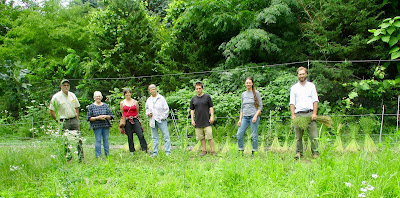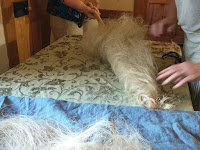Flax to Linen the Low Technology Way
It's been a busy time during the last month as high summer is drawing to a close. Scott Johnson of the Low Technology Institute https://lowtechinstitute.org and I took some time away from working, building, and gardening to teach a three-part workshop on growing, processing, and spinning flax.First, just a touch of history (I promise). Flax is a plant fiber, unlike wool, and requires cultivation to produce useable fiber. Flax has been used since ancient times to create beautiful, hand spun, handwoven linen fabrics that would seem almost impossible to recreate today. Flax was, literally, worth its weight in gold in Egypt. Linen mummy wrappings were made from flax, and, of course, the pharaohs wanted only the very best for their trip to the afterlife. Those very revealing garments worn by women in the tomb paintings of those pharaohs - very fine, very sheer linen.
Flax was also grown throughout Europe and is known to have been used to produce cloth at least 3,000 years ago in England - way, way, way before the spinning wheel was even imagined. And flax has crept into our English lexicon in all kinds of sneaky ways, as you will soon discover.
Before cotton was available, linen was used for everything from sheets and towels to underclothing. And in case you're wondering: no, people didn't wear the same clothes every day all year round for years on end. They may have only had one or two outer garments at a time, usually made from wool, but they changed their linens (their underwear made from linen) quite frequently to keep themselves as clean as possible. You might only have two sets of outer clothes, but you had a bunch of linen unmentionables. If you wonder why we have "linen sales" today, it's because sheets and pillowcases were also made of linen back then. Unlike cotton, linen lasts. It was common for linen items to be listed in a will. Many people have been given their grandmother's linen tablecloths and napkins, and they never seem to wear out.
There's a reason that fine linen fabrics are so expensive, though. The process of converting flax plants into linen yarn to be woven into fabric is time-consuming and labor intensive in the extreme. It takes a ridiculously long time to do it - so much so that one has to wonder who came up with the idea in the first place and why. However, in a world where fossil fuels were minimal, such as the Victorian era, flax and wool would have been two fibers that could be grown, harvested, and processed our local area.
Not just any old flax seed will work for fiber. If you imagine that you're going to be able to go to the local co-op, scoop up a pound or two of seed, plant it, and have fiber to spin, you will be sorely disappointed. There are two kinds of flax: the type for seeds and the type for fiber. Almost all of the flax grown nowadays is the type for seeds only, and the plants are completely unusable for fiber. The varieties that produce fiber are hard to come by and are often imported.
Scott has been growing a small plot of flax for about three years now, and the first half of our workshop series centered around growing and processing flax. On the first day of the workshop Scott took the participants through the planting and growing process, including instructions from The Book of the Farm published in 1842 by Henry Stephens. Spanning three volumes, 91 chapters, and 1384 pages, it was the farming bible of its day.
Toni harvesting flax
After learning the basics of planting and growing, everyone trooped off to the flax field to harvest the flax. We spent a good while pulling the long, thin stalks out of the soil by hand. Flax is harvested by pulling up the plants rather than cutting them down. Thankfully that's easy to do on Scott's small plot, but it would be back breaking labor in a large field under a summer sun.
The plants are then tied into bundles with more flax and laid out to dry in the sun. I have to admit that my bundle tying skill was seriously wanting. The bundles held together - barely. I'm a good spinner but a lousy bundler.
Brian bundling flax like a pro.
Flax bundles along the fence line
The flax harvesting crew
Scott teaching his son, Felix, about the mysteries of flax. Felix was quite interested in it.
After the flax dries out a bit, it's time to ripple and ret it. Rippling is done by passing the tops of the flax stalks through a giant comb which pops the seeds off the plants so they can be saved for next year's crop. With the scarcity and expense of those European seeds, every seed saved from Scott's flax crop counts toward a larger plot each year.
Retting is just a fancy word for rotting. If you have a nice, dewy lawn and about five weeks to spare, you can spread your flax out, flip it over every couple of days, and have lovely, silvery, "dew retted" flax. The faster, but smellier, way is to submerge it in water for about 10 days until the outer part of the stalk begins to rot away You know the smell of a lake in the middle of summer when the water level goes down and the lake weed starts to rot? That's the smell. It's fairly awful. Scott retted a crop in his canoe, and I wonder if the smell ever came out. It tends to linger. (Correction: Scott says this only takes five days in his experience. He did not, however, minimize the extent of the smell.)
After retting, the flax is allowed to dry out again, which takes most of the evil smell away, and then it's time break it. This sounds like some form of medieval torture, and if you look at a flax break, you might be inclined to agree.
My antique flax break
Ani hammering away with the flax break.
The next step is scutching. Scutching comes from the Old English or Scottish word scutch meaning "to beat or whip". Sounds lovely, doesn't it? The piece of wood that is being used is called a "scutching sword". Oh, dear...
 Scott takes a handful of the hackled flax he's been working on, goes twisty-twisty, and, hey, presto! a perfect strick lies in his hand. You would think, being a master spinner, this would be a piece of cake for me. Nope. I take my handful, set my tongue just so and whine and grumble and curse the day I ever laid eyes on this stuff, and eventually I am rewarded with a less than perfect, but still serviceable, strick. By the way, strick appears in English about 1400 A.D. and is apparently the root form of "strike". More torture. Poor flax.
Scott takes a handful of the hackled flax he's been working on, goes twisty-twisty, and, hey, presto! a perfect strick lies in his hand. You would think, being a master spinner, this would be a piece of cake for me. Nope. I take my handful, set my tongue just so and whine and grumble and curse the day I ever laid eyes on this stuff, and eventually I am rewarded with a less than perfect, but still serviceable, strick. By the way, strick appears in English about 1400 A.D. and is apparently the root form of "strike". More torture. Poor flax. A distaff is a stick of some kind that you tie your flax onto. It can be attached to your wheel like so:
We sat in Scott's parlor and chatted about all manner of things while we fanned out our fibers. Among other topics, I learned all about the various methods of tanning leather, including brain tanning, which is not a conversation one usually overhears at a local Starbucks.
At the end of the class, we all laid our little skeins out on the floor to admire them - even Scott who had to be coaxed into showing his. It was fascinating to see the differences in the various skeins, and every participant showed promise in becoming a good flax spinner with practice.























